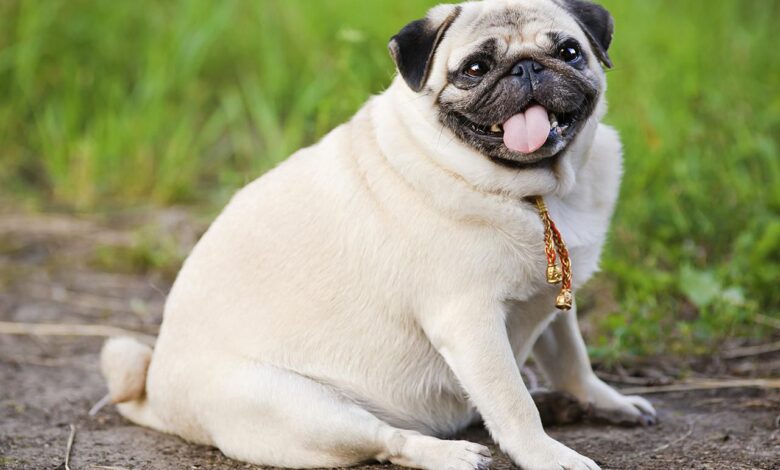
Obesity Management in Dogs – 2024 Guide
Studies indicate that the number of obese or overweight dogs continues to increase in number. According to VCA Animal Hospitals, about 25-30 percent of dogs are obese. Fortunately, obesity is one of the most preventable dog diseases.
What is Obesity?
Obesity refers to an accumulation of excess body fat, which goes hand in hand with extra body weight. In short, overweight dogs will mostly have body fat weight.
It is easier to measure if a dog is overweight through a bodyweight assessment than checking body fat. Most dogs are considered overweight when they weigh 10-20 percent above their ideal body. This is when using body weight as a guide. If they are 20 percent or above their ideal weight, the dogs are considered obese.
How to Tell if Your Dog is Obese

Try and feel around the ribs and spine to locate to see if your pet should shed a few pounds. It would help if you located both, with only a thin, fat layer separating the skin from the bones. If you cannot feel the ribcage, your dog is overweight.
Your vet can evaluate the size of your pup at every check-up. Ask the animals’ optimal weight once your canine reaches maturity to ensure that your dog is on track. It is also a good idea to invest in a pet insurance policy that is reliable and affordable such as the Bivvy pet insurance plan to cover your routine vet check-ups.
You can also use your home scale to estimate the dog’s weight. Step on the scale without the pet, then step on it again, holding the pet. The difference in the weights is the closest weight of your dog. Invest in a baby scale for small breeds.
Your pet must be weighed on the same scale consistently for better monitoring.
Are Some Breeds More Prone to Obesity than Others?

Despite the best efforts and care from pet parents, some pets still become obese frustrating the caregivers. A genetic factor contributes to weight; hence, dog and cat breeds are more susceptible to obesity than others. POMC, also known as pro-opiomelanocortin, is strongly associated with dogs’ obesity, appetite and weight. This is because the gene is an essential factor in regulating the brain’s recognition of hunger and feeling full after a meal.
As a result, the more copies of the variant (POMC) that your pet has, the more food motivated and heavier they are.
Dog breeds with a higher prevalence of obesity are cairn terrier, cook spaniel, labrador retriever, scottish terriers, and dachshunds.
Managing Obesity in Dogs
Check Your Dog’s Diet

Diet is one of the most common ways that make dogs overweight. Most pet parents choose the wrong diet leading to overweight. People want to make their pets happy and express their love through food. Giving your dog treats or snacks between meals is a significant cause of overweight in pets.
Serve your dog the correct amount of food. Most companies place information on the labels and may include directions on their websites. Getting your vet advice is crucial as many variables are factored into the equation in feeding your pet.
Put Your Dog on a Diet
When doing a meal plan for your obese dog, please pay careful attention to what they eat daily. Take an honest assessment of what your dog feeds on, including all snacks and treats. In some cases, dogs are fed by neighbors, family members, dog sitters, and walkers; consider these feeds as well.
Try and reduce the food portion by 15% to 20% for six to eight weeks., and then analyze the results. Your vet can also advise on the number of calories your dog needs daily to lose weight based on their ideal body weight, general health, energy level and current size.
While it is impossible to implement a no-treat policy, choosing healthy treats from reputable companies like Tail Bangers is an excellent way to manage obesity. Even with this nutrient-rich option, watch out for the intake quantity of your dog. You can serve the quantity for the day, and when it is finished, do not replenish.
Do Not Give Into Begging

When your overweight dog cries or whines for more food, stay put and do not give in. All you need to ensure is to serve your pup the correct food portion. More food will lead to obesity.
Get Your Dog into Exercising
Exercise is as crucial for pets as it is for people. If you are busy, you can engage the services of a teenager looking to earn something extra. You can also check out for doggy daycares, great options if you have no one at home where they can run and play.
Experts advise on about 10-15 minutes of activity several times a day. Take a walk or run either in the early morning or evening if you live in a hot area. Dogs that overheat easily or heavier ones will enjoy swimming more than others.
Risks Associated with Obesity

Obese dogs suffer a litany of potentially devastating health issues like trouble breathing, pancreatitis, orthopedic concerns, diabetes, compromised immune system, reduction in life span, skin conditions, high blood pressure and heart conditions, among others.
Obesity as a Sign of Medical Condition
If all the above tips do not work, consider seeing a vet as some weight gain may be due to underlying health conditions. The doctor may perform blood tests to confirm or rule out the conditions that include low thyroid levels and hormonal imbalances.
Conclusion

Obesity management starts with a step in the right direction. Work on the journey gradually and expect to see significant improvement in several months. If your pet loses 1 percent of the initial weight per week, that step is in the right direction. Once you achieve the results, you are looking for, develop healthier habits




